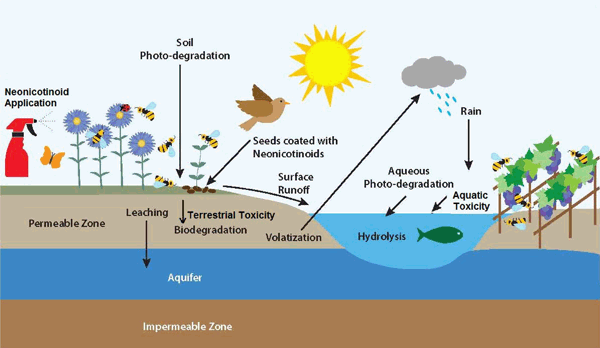The widespread adoption and use of neonicotinoid compounds originally considered to be environmentally benign can now potentially be considered to be an environmental catastrophe. While the generational development and production of neonicotinoids has focused on making these insecticides more potent to their target organisms at very small dosages, their adverse environmental consequences have largely remained overlooked. Imidacloprid was the first generation neonicotinoid to receive widespread attention for its environmental consequences. The third generation of neonicotinoids, dinotefuran, is several orders of magnitude more soluble in water than the first generation (imidacloprid 610 mg/L; thiamethoxam 4100 mg/L; dinotefuran 39,830 mg/L), in addition to being more potent and persistent. In 2008, the Environmental Fate and Effects Division (Environmental Risk Branch V) of the US EPA, acknowledged via a memorandum the potential risks that neonicotinoids present for non-target species such as upland game birds, endangered aquatic invertebrates in both freshwater and marine environments and secondary toxicity to fish due to alteration of food chains. There is a mounting body of evidence of adverse effects that neonicotinoids can cause in non-target species (honeybees, butterflies and moths, earthworms, bumblebees, solitary bees). In 2013, the EU placed a 2-year moratorium on the entire class (first–third generations) of neonicotinoids used in the agriculture operations that involve and attract honeybees such as seed treatment, soil application (granules) and foliar treatment on plants and cereals. This moratorium was established upon recommendation from the EU Food Safety Authority, and was based partly on body of evidence and partly under the broad umbrella policy of ‘precautionary principle’. The USA has not yet banned the use of neonicotinoids in agriculture applications. This is because the US Environmental Protection Agency (US EPA) operates under a “risk-based principles” policy: if the risk due to exposure to neonicotinoids is not clearly demonstrated, no efforts will be made to ban the use of neonicotinoids. However, on January 6, 2016, the USEPA formally acknowledged the risk that neonicotinoid exposure presents for honeybees. Through its preliminary risk assessment prepared in collaboration with the State of California’s Department of Pesticide Regulation, the US EPA has now established the threshold residual concentration of imidacloprid for honeybees at 25 parts per billion—and has stated that any exposure to imidacloprid above this limit will likely result in decrease in bee populations.
Source: Kurwadkar, S. & Evans, A. Bull Environ Contam Toxicol (2016). doi:10.1007/s00128-016-1968-3

- Login om te reageren
